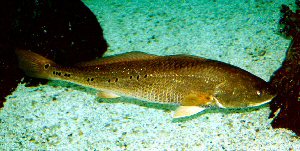Angling: Annual Red Bull Run
Wednesday, August 22nd, 2012
Bull Redfish, TPWD website
This is Passport to Texas
Texas anglers look forward to the annual running of the bulls — bull redfish, that is.
07—It’s large schools of mature red drum – male and female – aggregating near gulf passes to spawn.
Bill Balboa is ecosystem leader for Galveston Bay system. The bull red run begins in late August, crescendos about mid September, and continues through the fall. And these fish, most over 28-inches long, give anglers a good fight.
20 –They call them bulls for a reason, and it’s because they’re very strong fish; they don’t give up easily. So generally most anglers are going to fish for bull reds in the surf using what I would consider typical surf tackle — which is a little bit heavier rod and reel, because what they can expect is a lot of long runs from this fish. They pull very hard. Much like a bull would pull if you had it on a rope.
Although anglers can reel in bull reds all along the gulf coast, their best opportunities lie north of Matagorda Bay.
08—A lot of bull red fishing occurs in Sergeant up off of Freeport; Crystal Beach and Bolivar, in that area, and off of Sabine Pass.
And redfish is good eating. Keep an eye on the Texas Parks and Wildlife YouTube channel in the weeks ahead for a cooking segment with Chef Jesse Griffiths, preparing redfish three ways.
The Wildlife and sport fish restoration program supports our series and celebrates 75 years of funding diverse conservation projects throughout Texas…
For Texas Parks and Wildlife…I’m Cecilia Nasti.


 Passport to Texas is a
Passport to Texas is a  Passport to Texas is made available by:
Passport to Texas is made available by: